Welcome to another edition of Bookmarked! This week, Johanna Draper Carlson of Comics Worth Reading joins Kate and I as we talk about what’s on the top of our reading stacks this week. I’ll start:
 Brigid: I have been reading CLAMP’s Legal Drug a few pages at a time, which is really not the way to read it. I know this manga was a big deal back in the 2000s, but I have to confess I don’t always get CLAMP, and I’m finding this story somewhat tiresome because the characters all seem like types. The lead character, Kazahaya Kudo, was dying in the snow (for reasons that aren’t at all clear) when he was rescued by Rikuo, a young man who is as sullen as he is handsome. Now they live together and work for a pharmacy, but they spend a lot of time doing side jobs for the overly winsome owner of the business. The tasks they are assigned seem impossible—catch an invisible firefly—and they are given no direction, although they do have special psychic powers to fall back on. The puzzle part of it is interesting, and the art is lovely, but I just can’t warm up to any of these characters. It is nice, though, that Dark Horse has collected it into a single, thick omnibus, and that makes it easy for me to keep on plowing through it.
Brigid: I have been reading CLAMP’s Legal Drug a few pages at a time, which is really not the way to read it. I know this manga was a big deal back in the 2000s, but I have to confess I don’t always get CLAMP, and I’m finding this story somewhat tiresome because the characters all seem like types. The lead character, Kazahaya Kudo, was dying in the snow (for reasons that aren’t at all clear) when he was rescued by Rikuo, a young man who is as sullen as he is handsome. Now they live together and work for a pharmacy, but they spend a lot of time doing side jobs for the overly winsome owner of the business. The tasks they are assigned seem impossible—catch an invisible firefly—and they are given no direction, although they do have special psychic powers to fall back on. The puzzle part of it is interesting, and the art is lovely, but I just can’t warm up to any of these characters. It is nice, though, that Dark Horse has collected it into a single, thick omnibus, and that makes it easy for me to keep on plowing through it.
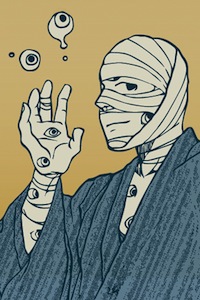 Anomal, by contrast, is a slim volume filled with lots of interesting characters. It’s a collection of short stories about the interactions between humans and yokai, and although they are all by the same creator, they vary quite a bit in tone. The character on the cover is a hyaku-me, or “hundred-eyes,” and he only figures in the first story, which is a shame as he’s a striking character. Some of the tales touch on deep emotions such as love, loss, and indebtedness, but there are a couple of semi-humorous ones, too. Unfortunately, the longest story is also the most annoying, about a schoolgirl who wants to become a yokai master because she loves to hug yokai. Nukuharu has an interesting way of drawing yokai, but like the stories, the art is uneven. I would love to see a more polished work from this creator, but Anomal is an interesting work and very different from the usual run of yokai tales.
Anomal, by contrast, is a slim volume filled with lots of interesting characters. It’s a collection of short stories about the interactions between humans and yokai, and although they are all by the same creator, they vary quite a bit in tone. The character on the cover is a hyaku-me, or “hundred-eyes,” and he only figures in the first story, which is a shame as he’s a striking character. Some of the tales touch on deep emotions such as love, loss, and indebtedness, but there are a couple of semi-humorous ones, too. Unfortunately, the longest story is also the most annoying, about a schoolgirl who wants to become a yokai master because she loves to hug yokai. Nukuharu has an interesting way of drawing yokai, but like the stories, the art is uneven. I would love to see a more polished work from this creator, but Anomal is an interesting work and very different from the usual run of yokai tales.
Kate: I read Legal Drug about eight years ago. Though I loved it then, I’m not sure I’d be as enthusiastic about Legal Drug now. I still find CLAMP’s artwork elegant, but I agree with your assessment of the characters: they’re paper-thin collections of tics and mannerisms that grow tiresome quickly.
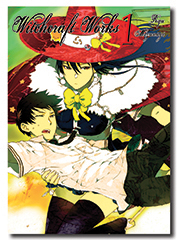 My nightstand is overflowing with new Vertical Comics. First up for me is volume one of Witchcraft Works, a series that falls squarely under the heading of Manga for Teenage Boys. The story focuses on Honoka Takamiya, a nebbishy high school student who has inexplicably attracted the attention of the class queen, Ayaka Kagari. After Ayaka rescues Honoka from an army of vicious stuffed rabbits — yes, it’s that kind of manga — we learn that Ayaka has been tasked with protecting Honoka from her fellow witches.
My nightstand is overflowing with new Vertical Comics. First up for me is volume one of Witchcraft Works, a series that falls squarely under the heading of Manga for Teenage Boys. The story focuses on Honoka Takamiya, a nebbishy high school student who has inexplicably attracted the attention of the class queen, Ayaka Kagari. After Ayaka rescues Honoka from an army of vicious stuffed rabbits — yes, it’s that kind of manga — we learn that Ayaka has been tasked with protecting Honoka from her fellow witches.
I’ll give creator Ryu Mizunagi credit: he wastes no time on exposition, diving into the action in the very first pages. Later chapters are denser in explanation, but generally read like conversations, rather than convenient exchanges of information for the reader’s benefit. I’m a little “meh” on the art, as it’s been calculated to appeal to the male gaze; most of the female characters are comically well endowed. (Several would topple over in real life, given their otherwise slender proportions.) There’s a fair amount of mammary-oriented fanservice and silly outfits, as well as an element of male wish fulfillment that just doesn’t resonate with an older female reader like me.
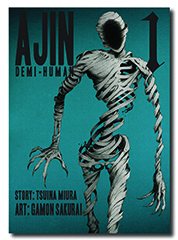 More promising is Ajin: Demi-Human, a supernatural thriller that starts slowly but builds momentum quickly. The first ten or so pages are a chore to read, as author Tsuina Miura provides a detailed explanation of what demi-humans are—they’re immortal—and how many walk the earth. (Hint: not many.) After this clumsy intro, however, the author delivers a nasty jolt: seemingly ordinary teen Kei Nagai learns the hard way that he’s immortal when he survives a hit-and-run accident with a truck. The intense media interest in this discovery forces Kei to go on the lam to avoid bounty hunters, government agents, and evil scientists.
More promising is Ajin: Demi-Human, a supernatural thriller that starts slowly but builds momentum quickly. The first ten or so pages are a chore to read, as author Tsuina Miura provides a detailed explanation of what demi-humans are—they’re immortal—and how many walk the earth. (Hint: not many.) After this clumsy intro, however, the author delivers a nasty jolt: seemingly ordinary teen Kei Nagai learns the hard way that he’s immortal when he survives a hit-and-run accident with a truck. The intense media interest in this discovery forces Kei to go on the lam to avoid bounty hunters, government agents, and evil scientists.
A story likes Ajin lives or dies by its artwork, and manga-ka Gamon Sakurai proves he’s up to the task of bring Miura’s script to life. Kei’s accident, for example, is suitably icky and unsettling, leaving the reader as dumbfounded as the characters who witnessed it. Sakurai’s action scenes are crisply rendered, too—a big plus, considering how many pages of volume one are devoted to high-speed chases and hand-to-hand combat. My only nit-picky criticism is the character designs: although the adults look good, some of the teenagers have serious Manga Hair. That’s a minor complaint, however, considering how much I enjoyed volume one.
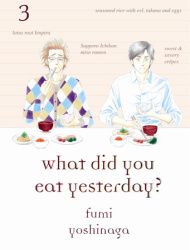 Also on my nightstand are volumes three and four of Fumi Yoshinaga’s What Did You Eat Yesterday? I admit that I began this series fully expecting to love it, but have been mildly disappointed thus far. The issue, for me, is the ratio of drama to shop talk. The vignettes exploring the relationship between Shiro, an uptight lawyer, and his partner Kenji, a cheerful hairdresser, are lovely, capturing the normal rhythms of a middle-aged couple’s life. We also get glimpses of each man’s work situation, and how they interact with peers and clients—another winning touch. The food talk, however, is less compelling. Though some of the dishes sound appetizing, I found these passages as tedious as listening to someone give a blow-by-blow account of an expensive meal. Your mileage may vary; if you live to eat, you may find these stove-side rhapsodies more engaging than I have.
Also on my nightstand are volumes three and four of Fumi Yoshinaga’s What Did You Eat Yesterday? I admit that I began this series fully expecting to love it, but have been mildly disappointed thus far. The issue, for me, is the ratio of drama to shop talk. The vignettes exploring the relationship between Shiro, an uptight lawyer, and his partner Kenji, a cheerful hairdresser, are lovely, capturing the normal rhythms of a middle-aged couple’s life. We also get glimpses of each man’s work situation, and how they interact with peers and clients—another winning touch. The food talk, however, is less compelling. Though some of the dishes sound appetizing, I found these passages as tedious as listening to someone give a blow-by-blow account of an expensive meal. Your mileage may vary; if you live to eat, you may find these stove-side rhapsodies more engaging than I have.
Johanna: It’s been a while since I’ve had a chance to read any manga—too much life stuff getting in the way—but the bright side of that is lots of volumes to catch up on over the holidays from series I expect to enjoy. I did manage to dive into a few books recently, plus try a new one-shot.
Let’s start with one of my current favorites, What Did You Eat Yesterday? Volume 5 is just out, and every new book for me is a reminder that I’m thrilled that we’re getting this series in English. I adore Fumi Yoshinaga’s art, and her combination of recipe how-tos and small moments of daily life for a gay couple works well. I keep thinking I’m going to try one of the dishes Shiro prepares, but they’re too domestic. They use short-cut bottled sauces and whatever he gets at the local grocery, which is realistic (someone who has to get dinner on the table every day doesn’t spend a lot of time making fancy dishes) and a great insight into his personality, but that makes them difficult to replicate in the U.S. Yet that cultural authenticity adds another level of enjoyment. I need to learn to mimic how he thinks about meals, with easy but balanced side dishes included, instead of getting caught up in the details. I’m not sure I could filet my own whole fish in my kitchen, the way Shiro does, either.
Ha! I originally typoed “meals” as “males” above, which leads into the other piece of the work, the comfortable relationship between the two men. It’s not about what Shiro and Kenji say, specifically, to each other in an evening, it’s that they’re sharing the details of their experiences. Some of them are dramatic, as when Kenji explains how his father abandoned his family. There’s a good deal of humor, too. Early on, a friendly housewife’s husband tries to make Shiro friends with the other gay guy he knows just because they’re both gay. Anyone who’s been matched up on a superficiality can ruefully relate to that. Overall, I never know what a new chapter will bring, which I like a lot.
Reaching further back, I also read Volume 5 of Genshiken: Second Season. I don’t always know exactly what’s going on with the characters, since they’re so fannish and detailed about media I’m unfamiliar with, but I can appreciate their dedication to their hobbies, even if this go-round for the series is a lot about cosplay and yaoi.
The one character I remember best from the previous series, the terminally nerdy Madarame, is still hanging around the college club, although he’s graduated. The younger club members have decided to do him a favor by orchestrating him being in the club room with the girl he’s had a crush on for four years. The encounter plays out in a way I found totally unexpected, but quietly charming and good-hearted. That’s why I’m still “hanging around” with these wackos—it’s like being part of your own group of fans, virtually. The details may vary, but the underlying love and dedication, even when taken to extremes, is similar. I also like the way each chapter is followed up by four 4-koma strips that comment on the events we’ve just seen.
In my own burst of fannish trivia, it’s part of the cosplay girl’s (I don’t know any character names beyond “Sue”) character that she’s very large-breasted, in contrast to her sweet, unassuming personality (when she’s not dressing up). In some of the outfits she wears here (and the chapter where she’s topless), I was reminded of what they used to say about Wally Wood drawing Power Girl, that he told his assistants that he was going to keep drawing her bigger and bigger until they made him stop … and they never did.
From sex to violence. I also read Judge, volume 5, although I am embarrassed to admit it. I only keep up with it because I’m lucky enough to get review copies. (If not, I’d be getting it out of the library, because I only want to buy series I expect to reread, and once the final villain is revealed, I suspect my interest will disappear entirely.) Next volume is supposedly the last, and I’m glad, the same way I’m glad when they cancel a TV show I should have stopped watching several episodes before but couldn’t quite break the habit on.
It’s one of those “a bunch of random people are told to kill each other one by one” stories—and why did Japan develop that genre?—that’s gone on too long. There are a couple of revelations in this book that I think are supposed to be interesting and provide twists, but I just want it to be over. Especially since it’s turned into a mini-harem, with our nice-ish guy protagonist mostly dealing with three girls. I expected more from it, with the original theme of the seven deadly sins, but I can’t keep up with who had which animal head which was what sin. Really bad pacing, this series has.
My one new read was The Garden of Words, which I failed. Remember when I said things had been really busy lately? As a result, I’ve been in a super-charged mood of “let’s get more stuff done,” and I want what I’m reading to keep up. This book is the exact opposite. It’s about an older woman and school-age boy who meet at a gazebo when it rains. It requires leisurely reflection and an awareness of connections in life and pondering how someone can affect our lives temporarily but then we move on.
I was in totally the wrong mood for it. I’m going to try reading it again when I can better calm myself and approach it on its terms before I decide whether it’s too much like other things I’ve read or has its own special qualities.
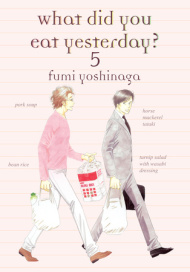
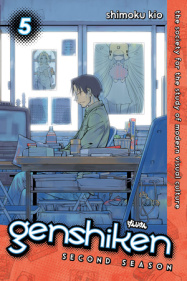
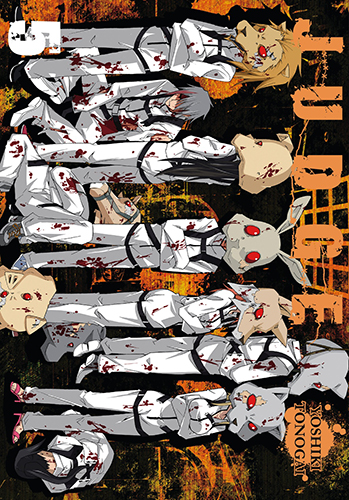
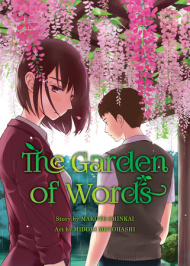
The cosplay girl is Ono. I don’t think it was so much that her breasts were actually drawn larger in this volume as that the rather skimpy costume she was wearing for much of the school festival storyline—and the fact that she was uncharacteristically topless for another scene later—drew the viewer’s attention to them more emphatically than in many of the previous volumes, where she spent most of her time rather modestly dressed in things like turtleneck sweaters.
The other thing about Ono’s breasts is that, now that practically everyone else in the club is female, I keep expecting one of the other girls (probably Yoshitake [I think that’s her name], the thin bespectacled one who’s so fond of rather intrusively speculating about various aspects of other people’s personal lives, such as whether the club’s depressingly pretty resident cross-dresser shaves all his body hair) to ask Ono where the heck she gets her bras, since she looks as if she’d need at least a size DD (in U.S. measurements), which would probably be pretty difficult to obtain in Japan.
In the one manga I’ve seen where this sort of practical question is addressed, the well-endowed character in question told her cousin that she had to order bras imported from abroad. So I’ve basically been assuming that Ono gets Angela (her other American friend who came to visit along with Sue before Sue actually transferred to the Genshiken’s parent college in Japan) or somebody else Ono knows from back when she went to high school in the U.S. to buy bras for her there and ship them to her.